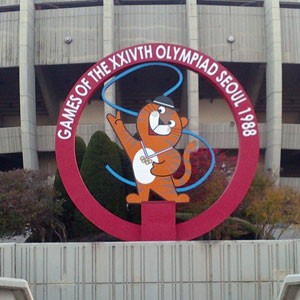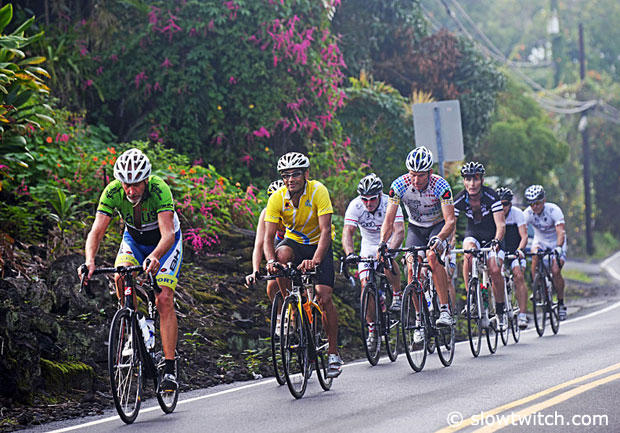Gibraltar Top of the Rock run
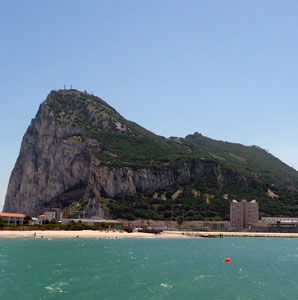
Chris Walker is a citizen of Gibraltar who was racing in the M45-49 division. When he posts on the Slowtwitch.com reader forum, Chris goes by the handle "Gibraltar."
His home country is not known to be a hotbed of triathlon but for a community of only 30,000 people it has a fairly strong triathlon presence, and it obviously boasts some incredible topography that calls for some exploration. In this edition of our People and Places series, Chris Walker tells us a bit about himself, his tri community and one of the most incredible workouts that you could probably try, not simply because of its physical difficult, but because of where it is located.
A British Dependent Territory on the Southern most tip of Europe, Gibraltar sits across from Africa, and "controls" the access from the Mediterranean to the Atlantic. Nations have fought to control this strategic piece of rock. Own it and you also ended up with a lot of naval and commercial power. At least this is why it was so sought after. As a triathlete, you don’t need to conquer the Rock through military means. Instead of that, a run straight up to the top of the Rock, from sea level to its peak over 1000 feet above the water awaits you. To help with some visualization, to get ready for this run, you’ll need to get on your treadmill, put it as steep as it will go (generally a 15% grade) and then run as fast as you can until your heart jumps out of your chest.
Let’s see what Chris has to share.
Slowtwitch: We talked briefly in Kona. Welcome home. How long was your trip back halfway across the globe through 12 time zones?
Chris Walker: Coming home, door to door was 33 hours. On the way over to Kona, I broke it up part way to sleep at a connecting airport, so it was a 44 hour trip to get halfway across the world. We have to fly to somewhere in the US east coast from Hawaii, then to a European airport and then a final leg to the Rock.
ST: What brought you to Gibraltar in the first place and what do you do there for a living?
Chris: I grew up in the UK but initially came here for work 20 years ago, and then met my wife who is from here. Then we got married and stayed and I have been here ever since. I am a 45-year old retail manager, married with four children aged 16, 13, 10 & 5.
ST: How did you get in the sport?
Chris: I took up triathlon in 2000 having mainly played rugby up until that time and I have represented Gibraltar Internationally in rugby, athletics, cycling and triathlon. I am one of the founder members and president of the Gibraltar Triathlon Association, which was formed in 2000 and is a full and active member of ITU. I got into the sport of triathlon by chance whilst I was cross training trying to recover from a sprained ankle and as soon as I completed my first ever event, which was a sprint distance triathlon, I was completely hooked and have not looked back since.
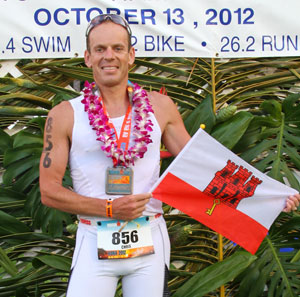
ST: You have actually achieved a lot in the decade since you got into triathlons. What are the highlights?
Chris: Highlights in triathlon are the 2002 Commonwealth Games Triathlon, 2002 Ironman World Champs, 2006 Commonwealth Games Cycling, 2008 Ironman 70.3 World Champs, 2010 Commonwealth Games Cycling and 2012 Ironman World Champs. PRs are Olympic 1hr 55min Seville 2011, 70.3 4hrs 19min Clearwater 2008, Ironman 9hrs 36min Frankfurt 2012.
ST: As an athlete, there are ups and downs. You’ve had your downs too and given some of the downs, the recent 9:36 in Frankfurt is very commendable.
Chris: Actually a lot of what I have done was achieved after a major setback. In 2005 I had back surgery to remove a small piece of herniated disk that was lodged against my nerve root from the L5-S1 area which resulted in some permanent nerve damage that affects my right calf muscle and I can no longer do a heel raise on my right leg which affects my running and whereas pre surgery running was my strongest discipline it is now my weakest.
ST: You are a busy family guy with a high-pressure job and it is not like the island has a ton of local territory to train on. How does a typical day play out?
Chris: A typical training day for me is a cycle session early in the morning, which is either 45mins on the turbo trainer or out on the roads for an hour or so followed by a 3km swim session at lunchtime and either a 7km run or 45 min cycle when I finish work. In addition to a 20km run on a Saturday and 125km bike early on Sunday I will usually manage between 12 and 18 hours a week of training.
ST: What is the tri community like where you live and where do you guys get most of your racing done?
Chris: The triathlon community in Gibraltar is tiny with approximately only 25 active triathletes but what we lack in numbers we make up for in enthusiasm and performances with the Gibraltar. Flag having been flown at both the 70.3 and Ironman World Championships in addition to the ITU AG World Championships.
There are only 30,000 residents in Gibraltar so in relation to our size I think we do very well and we have certainly seen a big rise in the amount of people taking an interest in triathlon over the past two years, which I am confident will continue. At the club level we race regularly in many of the excellent races of all distances in Southern Spain as the Hercules Triathlon Club and whilst the standards are very high in Spain (just look at Javier Gomez) we are still competitive as a club despite our low numbers.
ST: Now let’s get on to the meat of why we’re talking to you. We want to share with our readers interesting workouts and challenges from across the world. You have one literally out your back door and most of us have seen the venue on TV, in images or movies, but we probably have not thought of it in a triathlon context. Tell us more.
Chris: The Top of the Rock run is basically a 2.75 mile run from sea level to the top of the Rock of Gibraltar which is approximately 1000 feet. The first 0.25 miles is flat and then the remaining 2.5miles is all up hill, starting at a grade of 25 percent. I have always run the distance in one go rather than split it up into sections as I know that if I was to stop at any point I would not get going again!
The run takes in some of the most spectacular scenery of the Spanish coastline to Tarifa and also of the Atlas Mountains over the Straits in Morocco which does take away some of the pain of the run.
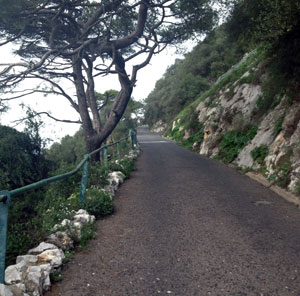
ST: How hard is it coming back down. Given your leg injuries, how does it affect you both up and down?
Chris: Prior to my back surgery I would jog back down but now I just walk as I no longer train on downhills which is probably why I was faster going up Palani this year than going down!
ST: From the look of your results in Kona, you did pretty well both up and down Palani. Sounds like this run would make Palani look flat, although if you keep running on Palani and don’t turn left on the Queen K, it can take you straight up to 5100 feet in one shot (with only one right turn). Anyway, what is the history behind the climb?
Chris: The Top of the Rock run has been going on for decades and is a very strong Naval tradition which is still in place today and whenever there are Navy ships in port there will usually be Service men and women running to the Top of the Rock.
ST: Give us a feel for how the thing plays out. Is there anything really technical
Chris: Technically it is not too bad with five or six switchbacks and the most challenging part is the relentless climbing and the fact that the steepest parts are at the beginning and the end, both at around 25 percent grade.
ST: It seems like a climb like this is simply calling for a race, or as a bare minimum a few benchmarks for accomplishment. Are there any timed climbs for this thing? If so, what is considered in local lore to be a good time?
Chris: I believe that the record is held by a Great Britain International Fell Runner who completed the run in 17 minutes and 28 seconds, and any time under 20 minutes is considered good. The fastest I have done is just over 20 minutes, which was before my back surgery and now I can only manage around 22 minutes at best.
ST: So putting this in perspective, if you put a treadmill on a 15% grade and run for 17 minutes and 30 seconds at around 9.5 mph then you’re in the range of the record holder. Since most of the guys like data, that might provide more perspective. For a 20 minute Rock climb, we’re talking around 8.3 mph treadmill speed, set at 15 percent grade for 20 minutes. That would spit most of us off the back of the treadmill within a few strides! What is the local climate like for this run? You are close to southern Spain so it can be like a blast furnace most of the summer
Chris: Not that bad really. We have the oceans to keep us cooler. In terms of climate our temps in January are in the mid 50’s and mid 80’s in July
ST: The Rock has been the scene for at least one Bond movie. How fast do you think James Bond could do it? Could he beat you?
Chris: I think James Bond would certainly be able to do the run although probably not under 20minutes unless "Q" provided him with some help!
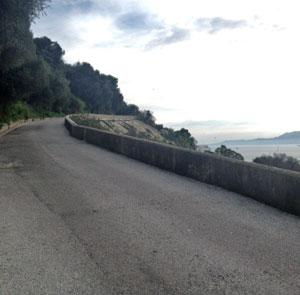
ST: Anything else you want to share with the readers? Seems like the world of Slowtwitch would need a local tour guide because some guy or girl who reads this is going to want to hop on an airplane, get over to the Rock and break 20 minutes. I think you need to organize some type of a triathlon with a finish at this summit?
Chris: If any Slowtwitchers are planning a visit to Gibraltar and would like to complete the run I would be more than happy to accompany them as long as I can keep up. We do have a local super sprint tri that is aimed at getting kids into the sport, at which we get around 150 participants. I have plans for an international Aquathlon, and yes, you know where the run course will finish…at the summit of the rock. Stay tuned.
ST: Thanks for sharing details about the Rock run. Sounds like you have a good set up locally. You have some interesting goals coming up in the next couple of years, which would be a bit unique for a person in M45-49? The Commonwealth Games (which are like the Olympics for British Colonies and former colonies) are coming up in the next 2 years?
Chris: For 2013 my main aim is to qualify for the triathlon at the 2014 Commonwealth Games and to do so I will need to go sub 1hr 59min for Olympic Distance in both a draft legal event and in a non-drafting TT in addition to fulfilling other criteria in order to have a chance of getting selected. Despite the fact that I will be 47 years old when the event takes place I am focused and motivated to try and achieve the times set and having lined up next to Simon Whitfield in Manchester in 2002 (who went on to win Gold.) I am more than aware that my performance will be nowhere near the world ranked athletes but a sub 1.59 qualifying time for an amateur is still a reasonable time in my opinion and I would be very proud to take my place amongst some of the Worlds Triathlon Elite.
We also have the Island Games Competition in 2013, which is a bi annual mini Olympics for Island Communities of less than 150,000 population and for 2013 it is being held in Bermuda with an Olympic Distance Triathlon event taking place. I won Silver in the 2003 Guernsey Games but with Tyler Butterfield (Bermuda) and Daniel Halksworth (Jersey) likely to be taking part I think my chances of a medal are unlikely this time round!
ST: Thanks for luring us to the Rock run. Hopefully you’ll have some international company joining you soon, in the mean time good luck on your upcoming goals!


